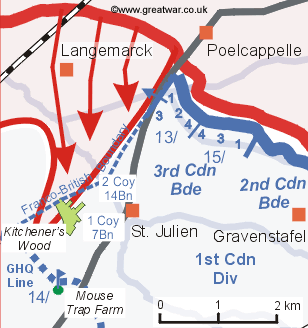Advanced Dressing Station (ADS), Essex Farm, Ypres Salient, Belgium
At the rear of Essex Farm cemetery, near the western bank of the Ieper-Ijser canal, there are WW1 battlefield remains in the form of a British concrete bunker with a series of rooms. The bunker was renovated and preserved in the 1990s as the site of a British Army Advanced Dressing Station (A.D.S.).
Origins of the Medical Station at Essex Farm
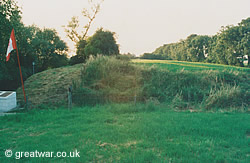
|
The photograph is taken looking north on the spoilbank of the western bank of the Ieper-Ijser canal (known in 1914-1918 by its French name of the Ypres-Yser canal).
The original medical dugouts, which were expanded into a dressing station by 1917, are located on the left side of this spoilbank in the photograph, near the flagpole. The canal is located on the right side of the spoilbank, immediately on the right of the line of trees.
Medical Station Established, April-May 1915
During the Second Battle of Ypres in 1915 a basic medical “station” for British Army casualties was first established in rough dugouts cut into the western bank of the Ypres-Yser canal at the rear of what is now Essex Farm cemetery.
A battle to defend the Allied ground in the northern Ypres Salient began on 22 April 1915, following the launch of a deadly new weapon of war by the German Army. It was a poisonous gas cloud. The battle became known as the Second Battle of Ypres. A few days before the battle started the British Army had taken over the north-eastern sector of the Ypres Salient from the French Army.
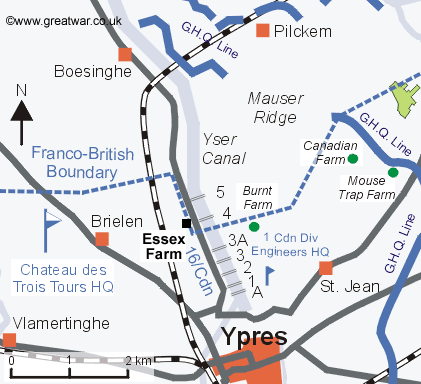
|
It was in the early morning of 23 April, a few hours after the surprise German gas cloud attack, that the 1st Canadian Field Artillery Brigade took up a position on the west bank of the Yser Canal just north of Bridge No. 4 (known as Brielen Bridge). Major John McCrae was with them. He was second-in-command of the brigade but was also a doctor by profession and thereby also the brigade surgeon. In the following days Major John McCrae tended the wounded in the dugouts cut into the spoilbank of the canal.
Soldiers' graves, mostly French at that stage of the fighting, were already in the area of the dugouts. A farm nearby to the position was named Essex Farm on British Army battlefield maps. This is believed to be the location where Major John McCrae wrote his famous poem In Flanders Fields after burying a friend, Lieutenant Alexis Helmer, on 3 May 1915. Lieutenant Helmer was buried in the burial plot in the vicinity of Essex Farm at that time, but his grave was subsequently lost.
“In Flanders Fields” poemAdvanced Dressing Station (A.D.S.) at Essex Farm
As the war continued in this sector the original crude dugouts in the canal bank were extended and reinforced with concrete. They gradually developed into a series of rooms and a larger medical station was built up with huts to cope with larger numbers of wounded. The location became established as an Advanced Dressing Station (A.D.S.). As such it was one of the places along the route of evacuation to the rear for a wounded soldier from the Ypres Salient north of Ypres.
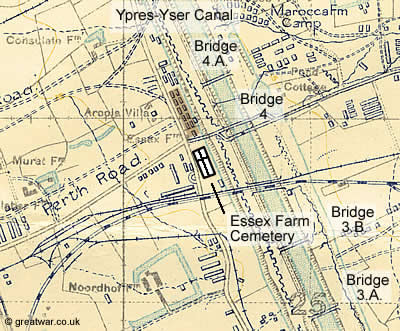
|
The trench map, dated 13 May 1918 (28.NW2. Edition 6A), shows Essex Farm and a number of huts (highlighted in brown on the west bank of the canal) which formed the Advanced Dressing Station. After the time in May 1915 when John McCrae was in this position, the area was developed with a railway line, narrow gauge railway lines and camps. A railway bridge had been added across the canal between Bridge 4 and Bridge 3.B. A defensive trench line can be seen on the western spoilbank of the canal. There is a hutted camp at MAROCCA FARM on the eastern side of the canal.
Essex Farm Advanced Dressing Station (A.D.S)
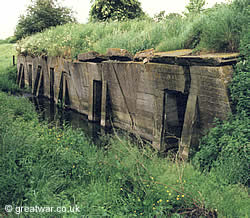
|
The photograph, taken in the late 1980s/early 1990s, shows the flooded remains of the original concrete medical shelters. They had fallen into disrepair by the 1990s.
Restoration of Essex Farm Advanced Dressing Station Bunker
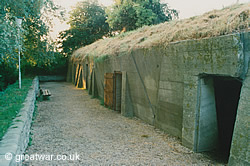
|
A project to renovate and preserve the surviving bunkers at the dressing station was carried out in the 1990s.
Layout of Essex Farm Advanced Dressing Station
A sketch, dated 1916 (original size: foolscap) drawn by A R Watt of the 69th Field Ambulance 1, shows the numerous concrete rooms and a one way route for ambulance cars at the Essex Farm ADS. The path on the right of the sketch leads from Essex Farm cemetery (bottom of the sketch) to the canal bank (top of the sketch). The path can be seen in the photograph below.
Text describes the purpose of each room and feature on the sketch (hover over the appropriate location to see the descriptive text).
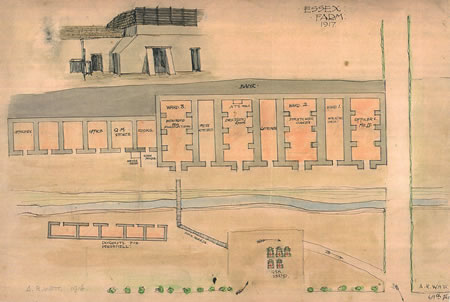
Location of Essex Farm Advanced Dressing Station
The preserved A.D.S. bunker is located at the rear of Essex Farm Cemetery. The cemetery is on the west bank of the Ieper-Ijser canal just north of the N38 northern ring road around Ieper.
Access to Essex Farm A.D.S. Bunker
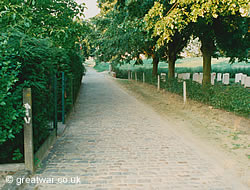
|
The photograph shows the path leading from the Boezinge - Ieper road onto the west bank of the Ieper-Ijser (Ypres-Yser canal). On the right of the path is Essex Farm cemetery.
The original location of the farm known as Essex Farm is on the left of the path. The Advanced Dressing Station bunker is located at the end of this path and on the left, before the path rises to cross the spoilbank of the canal.
Related Topic
Essex Farm Cemetery
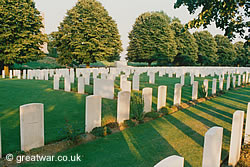
|
See our page about the cemetery located in the vicinity of the Advanced Dressing Station remains.
Essex Farm Cemetery is believed to be the location where the Canadian army doctor and artillery brigade Major drafted his now famous poem “In Flanders Fields the Poppies Blow...”:
Related Battle Study
Battle Study: The Second Battle of Ypres 1915
A section of this website features over 90 pages in a time-line study of the build-up to the German trial with gas as a new weapon of war. Read our in-depth prelude to this battle and the first hours of the German attack with gas against two French divisions in position to the east of the Ypres-Yser canal:
Battle Study: Second Battle of Ypres 1915
Acknowledgements
1 Sketch by A R Watt by kind permission of the Museum of Military Medicine, Keogh Barracks, Ash Vale, Aldershot, Hampshire:
Website: museumofmilitarymedicine.org.uk

